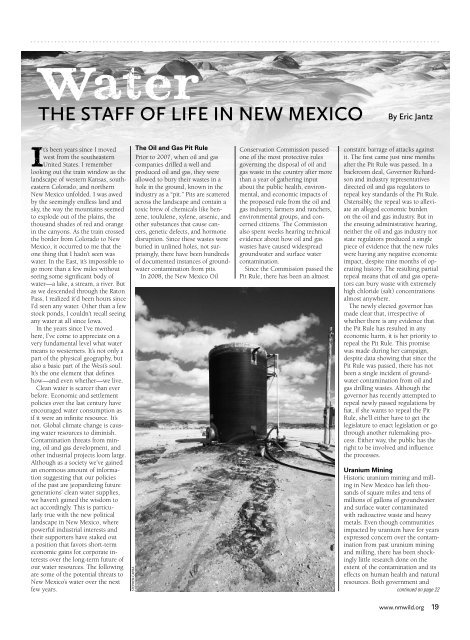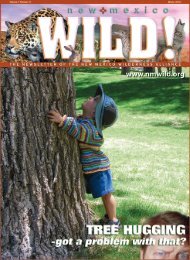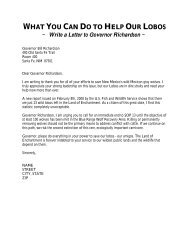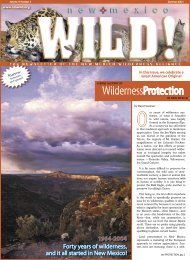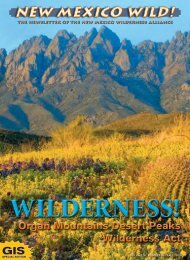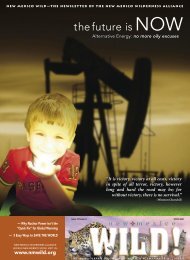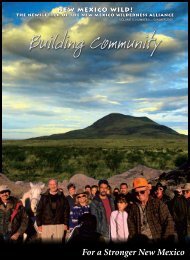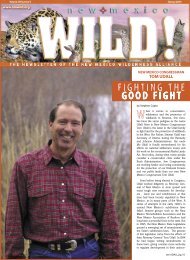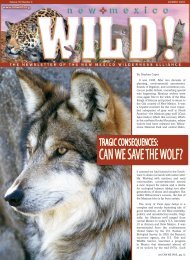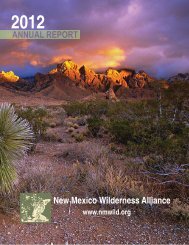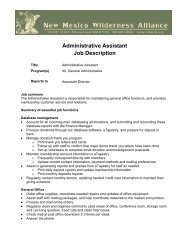Special Mobile GIS Issue - New Mexico Wilderness Alliance
Special Mobile GIS Issue - New Mexico Wilderness Alliance
Special Mobile GIS Issue - New Mexico Wilderness Alliance
You also want an ePaper? Increase the reach of your titles
YUMPU automatically turns print PDFs into web optimized ePapers that Google loves.
from the legal room<br />
Water<br />
The Staff of Life in <strong>New</strong> <strong>Mexico</strong><br />
By Eric Jantz<br />
It’s been years since I moved<br />
west from the southeastern<br />
United States. I remember<br />
looking out the train window as the<br />
landscape of western Kansas, southeastern<br />
Colorado, and northern<br />
<strong>New</strong> <strong>Mexico</strong> unfolded. I was awed<br />
by the seemingly endless land and<br />
sky, the way the mountains seemed<br />
to explode out of the plains, the<br />
thousand shades of red and orange<br />
in the canyons. As the train crossed<br />
the border from Colorado to <strong>New</strong><br />
<strong>Mexico</strong>, it occurred to me that the<br />
one thing that I hadn’t seen was<br />
water. In the East, it’s impossible to<br />
go more than a few miles without<br />
seeing some significant body of<br />
water—a lake, a stream, a river. But<br />
as we descended through the Raton<br />
Pass, I realized it’d been hours since<br />
I’d seen any water. Other than a few<br />
stock ponds, I couldn’t recall seeing<br />
any water at all since Iowa.<br />
In the years since I’ve moved<br />
here, I’ve come to appreciate on a<br />
very fundamental level what water<br />
means to westerners. It’s not only a<br />
part of the physical geography, but<br />
also a basic part of the West’s soul.<br />
It’s the one element that defines<br />
how—and even whether—we live.<br />
Clean water is scarcer than ever<br />
before. Economic and settlement<br />
policies over the last century have<br />
encouraged water consumption as<br />
if it were an infinite resource. It’s<br />
not. Global climate change is causing<br />
water resources to diminish.<br />
Contamination threats from mining,<br />
oil and gas development, and<br />
other industrial projects loom large.<br />
Although as a society we’ve gained<br />
an enormous amount of information<br />
suggesting that our policies<br />
of the past are jeopardizing future<br />
generations’ clean water supplies,<br />
we haven’t gained the wisdom to<br />
act accordingly. This is particularly<br />
true with the new political<br />
landscape in <strong>New</strong> <strong>Mexico</strong>, where<br />
powerful industrial interests and<br />
their supporters have staked out<br />
a position that favors short-term<br />
economic gains for corporate interests<br />
over the long-term future of<br />
our water resources. The following<br />
are some of the potential threats to<br />
<strong>New</strong> <strong>Mexico</strong>’s water over the next<br />
few years.<br />
stephen capra<br />
The Oil and Gas Pit Rule<br />
Prior to 2007, when oil and gas<br />
companies drilled a well and<br />
produced oil and gas, they were<br />
allowed to bury their wastes in a<br />
hole in the ground, known in the<br />
industry as a “pit.” Pits are scattered<br />
across the landscape and contain a<br />
toxic brew of chemicals like benzene,<br />
toululene, xylene, arsenic, and<br />
other substances that cause cancers,<br />
genetic defects, and hormone<br />
disruption. Since these wastes were<br />
buried in unlined holes, not surprisingly,<br />
there have been hundreds<br />
of documented instances of groundwater<br />
contamination from pits.<br />
In 2008, the <strong>New</strong> <strong>Mexico</strong> Oil<br />
Conservation Commission passed<br />
one of the most protective rules<br />
governing the disposal of oil and<br />
gas waste in the country after more<br />
than a year of gathering input<br />
about the public health, environmental,<br />
and economic impacts of<br />
the proposed rule from the oil and<br />
gas industry, farmers and ranchers,<br />
environmental groups, and concerned<br />
citizens. The Commission<br />
also spent weeks hearing technical<br />
evidence about how oil and gas<br />
wastes have caused widespread<br />
groundwater and surface water<br />
contamination.<br />
Since the Commission passed the<br />
Pit Rule, there has been an almost<br />
constant barrage of attacks against<br />
it. The first came just nine months<br />
after the Pit Rule was passed. In a<br />
backroom deal, Governor Richardson<br />
and industry representatives<br />
directed oil and gas regulators to<br />
repeal key standards of the Pit Rule.<br />
Ostensibly, the repeal was to alleviate<br />
an alleged economic burden<br />
on the oil and gas industry. But in<br />
the ensuing administrative hearing,<br />
neither the oil and gas industry nor<br />
state regulators produced a single<br />
piece of evidence that the new rules<br />
were having any negative economic<br />
impact, despite nine months of operating<br />
history. The resulting partial<br />
repeal means that oil and gas operators<br />
can bury waste with extremely<br />
high chloride (salt) concentrations<br />
almost anywhere.<br />
The newly elected governor has<br />
made clear that, irrespective of<br />
whether there is any evidence that<br />
the Pit Rule has resulted in any<br />
economic harm, it is her priority to<br />
repeal the Pit Rule. This promise<br />
was made during her campaign,<br />
despite data showing that since the<br />
Pit Rule was passed, there has not<br />
been a single incident of groundwater<br />
contamination from oil and<br />
gas drilling wastes. Although the<br />
governor has recently attempted to<br />
repeal newly passed regulations by<br />
fiat, if she wants to repeal the Pit<br />
Rule, she’ll either have to get the<br />
legislature to enact legislation or go<br />
through another rulemaking process.<br />
Either way, the public has the<br />
right to be involved and influence<br />
the processes.<br />
Uranium Mining<br />
Historic uranium mining and milling<br />
in <strong>New</strong> <strong>Mexico</strong> has left thousands<br />
of square miles and tens of<br />
millions of gallons of groundwater<br />
and surface water contaminated<br />
with radioactive waste and heavy<br />
metals. Even though communities<br />
impacted by uranium have for years<br />
expressed concern over the contamination<br />
from past uranium mining<br />
and milling, there has been shockingly<br />
little research done on the<br />
extent of the contamination and its<br />
effects on human health and natural<br />
resources. Both government and<br />
continued on page 22<br />
www.nmwild.org 19


